Strategic Management Analysis of J Sainsbury Plc using Porter Five Forces Model
VerifiedAdded on 2023/06/18
|12
|3836
|359
AI Summary
This report provides a strategic management analysis of J Sainsbury Plc using Porter Five Forces Model. It examines the potential of buyers and suppliers, competitive rivalry, threat of new entrants and substitution. The report also outlines strategies for improving business functions to enhance competitiveness.
Contribute Materials
Your contribution can guide someone’s learning journey. Share your
documents today.
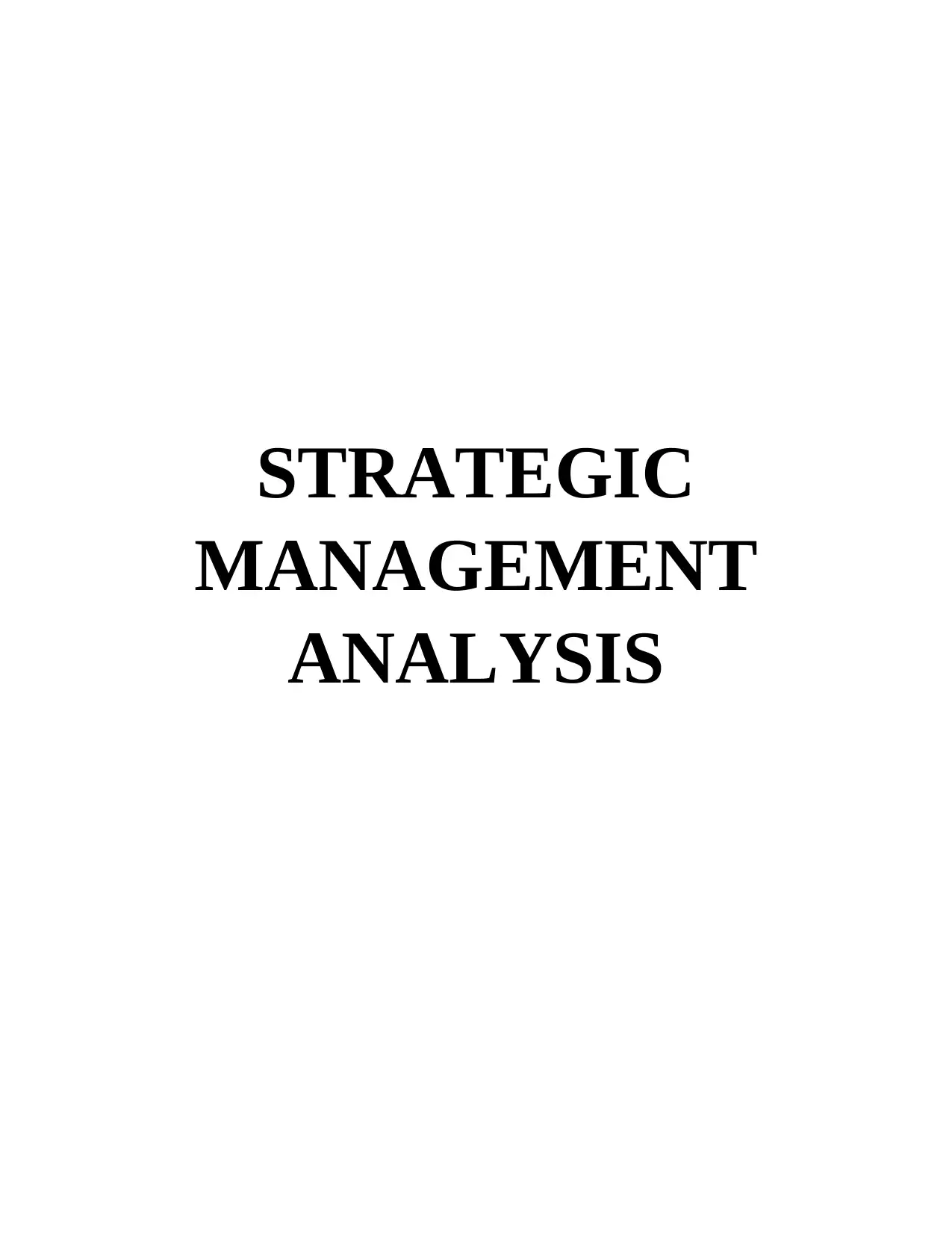
STRATEGIC
MANAGEMENT
ANALYSIS
MANAGEMENT
ANALYSIS
Secure Best Marks with AI Grader
Need help grading? Try our AI Grader for instant feedback on your assignments.
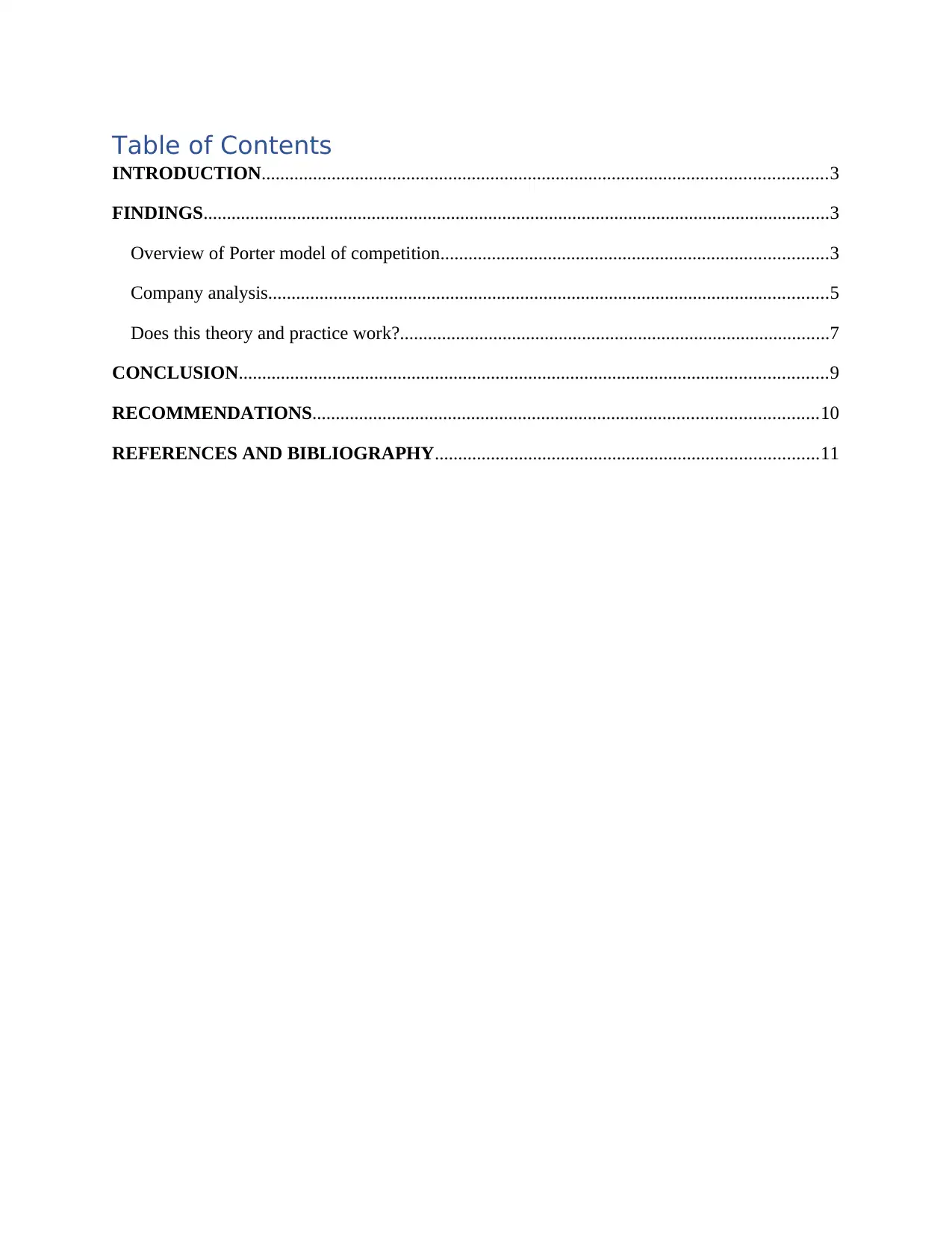
Table of Contents
INTRODUCTION.........................................................................................................................3
FINDINGS......................................................................................................................................3
Overview of Porter model of competition...................................................................................3
Company analysis........................................................................................................................5
Does this theory and practice work?............................................................................................7
CONCLUSION..............................................................................................................................9
RECOMMENDATIONS............................................................................................................10
REFERENCES AND BIBLIOGRAPHY..................................................................................11
INTRODUCTION.........................................................................................................................3
FINDINGS......................................................................................................................................3
Overview of Porter model of competition...................................................................................3
Company analysis........................................................................................................................5
Does this theory and practice work?............................................................................................7
CONCLUSION..............................................................................................................................9
RECOMMENDATIONS............................................................................................................10
REFERENCES AND BIBLIOGRAPHY..................................................................................11
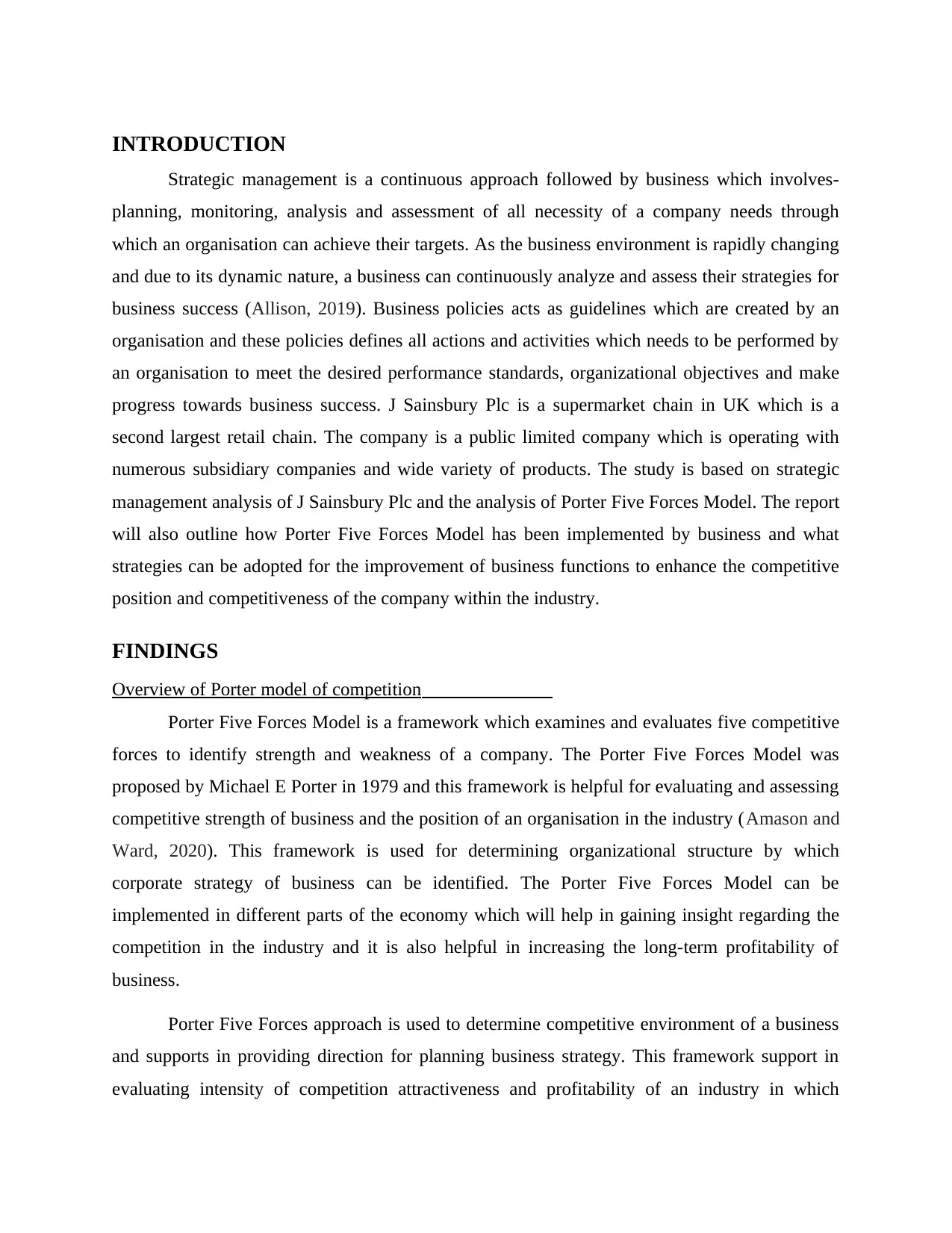
INTRODUCTION
Strategic management is a continuous approach followed by business which involves-
planning, monitoring, analysis and assessment of all necessity of a company needs through
which an organisation can achieve their targets. As the business environment is rapidly changing
and due to its dynamic nature, a business can continuously analyze and assess their strategies for
business success (Allison, 2019). Business policies acts as guidelines which are created by an
organisation and these policies defines all actions and activities which needs to be performed by
an organisation to meet the desired performance standards, organizational objectives and make
progress towards business success. J Sainsbury Plc is a supermarket chain in UK which is a
second largest retail chain. The company is a public limited company which is operating with
numerous subsidiary companies and wide variety of products. The study is based on strategic
management analysis of J Sainsbury Plc and the analysis of Porter Five Forces Model. The report
will also outline how Porter Five Forces Model has been implemented by business and what
strategies can be adopted for the improvement of business functions to enhance the competitive
position and competitiveness of the company within the industry.
FINDINGS
Overview of Porter model of competition
Porter Five Forces Model is a framework which examines and evaluates five competitive
forces to identify strength and weakness of a company. The Porter Five Forces Model was
proposed by Michael E Porter in 1979 and this framework is helpful for evaluating and assessing
competitive strength of business and the position of an organisation in the industry (Amason and
Ward, 2020). This framework is used for determining organizational structure by which
corporate strategy of business can be identified. The Porter Five Forces Model can be
implemented in different parts of the economy which will help in gaining insight regarding the
competition in the industry and it is also helpful in increasing the long-term profitability of
business.
Porter Five Forces approach is used to determine competitive environment of a business
and supports in providing direction for planning business strategy. This framework support in
evaluating intensity of competition attractiveness and profitability of an industry in which
Strategic management is a continuous approach followed by business which involves-
planning, monitoring, analysis and assessment of all necessity of a company needs through
which an organisation can achieve their targets. As the business environment is rapidly changing
and due to its dynamic nature, a business can continuously analyze and assess their strategies for
business success (Allison, 2019). Business policies acts as guidelines which are created by an
organisation and these policies defines all actions and activities which needs to be performed by
an organisation to meet the desired performance standards, organizational objectives and make
progress towards business success. J Sainsbury Plc is a supermarket chain in UK which is a
second largest retail chain. The company is a public limited company which is operating with
numerous subsidiary companies and wide variety of products. The study is based on strategic
management analysis of J Sainsbury Plc and the analysis of Porter Five Forces Model. The report
will also outline how Porter Five Forces Model has been implemented by business and what
strategies can be adopted for the improvement of business functions to enhance the competitive
position and competitiveness of the company within the industry.
FINDINGS
Overview of Porter model of competition
Porter Five Forces Model is a framework which examines and evaluates five competitive
forces to identify strength and weakness of a company. The Porter Five Forces Model was
proposed by Michael E Porter in 1979 and this framework is helpful for evaluating and assessing
competitive strength of business and the position of an organisation in the industry (Amason and
Ward, 2020). This framework is used for determining organizational structure by which
corporate strategy of business can be identified. The Porter Five Forces Model can be
implemented in different parts of the economy which will help in gaining insight regarding the
competition in the industry and it is also helpful in increasing the long-term profitability of
business.
Porter Five Forces approach is used to determine competitive environment of a business
and supports in providing direction for planning business strategy. This framework support in
evaluating intensity of competition attractiveness and profitability of an industry in which
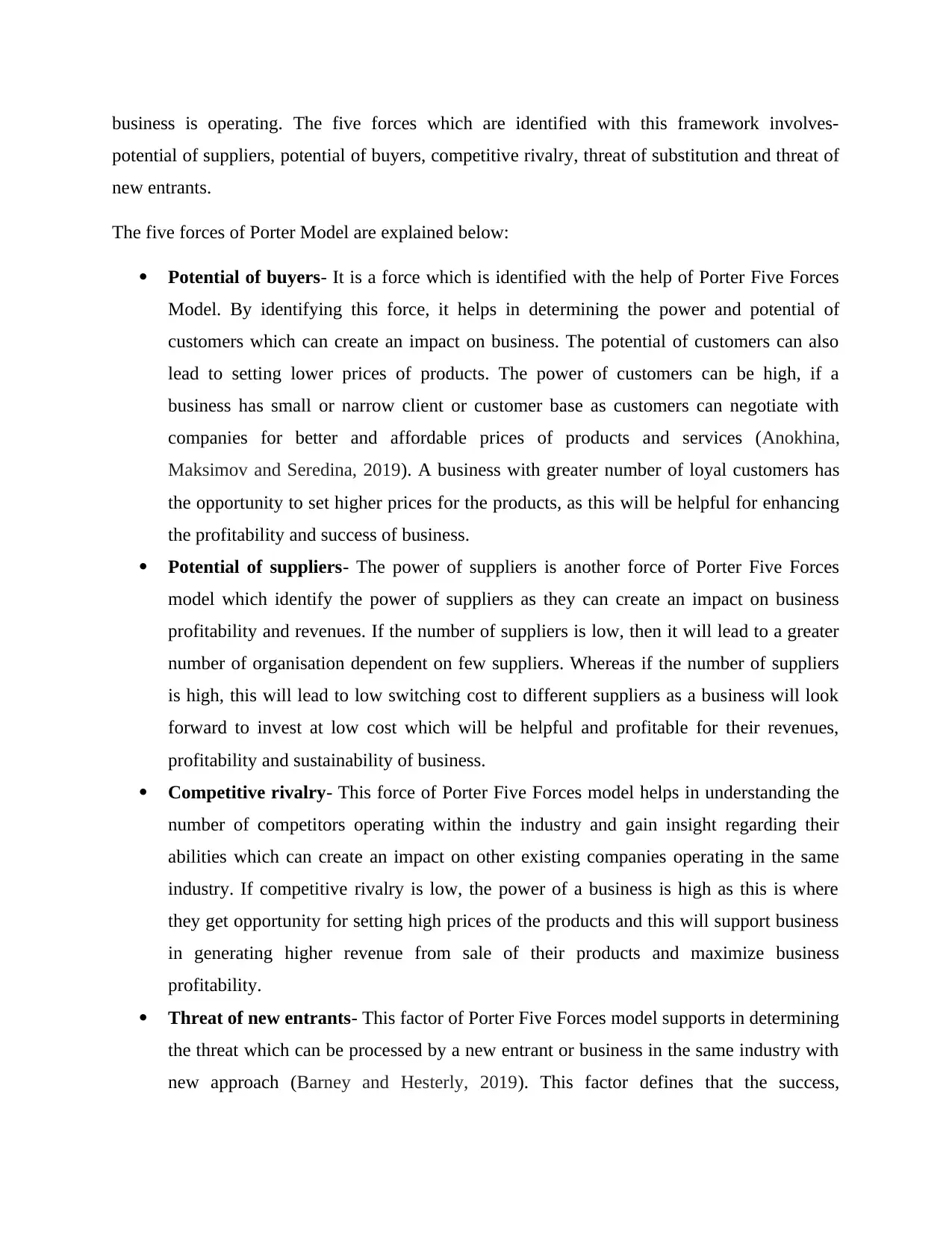
business is operating. The five forces which are identified with this framework involves-
potential of suppliers, potential of buyers, competitive rivalry, threat of substitution and threat of
new entrants.
The five forces of Porter Model are explained below:
Potential of buyers- It is a force which is identified with the help of Porter Five Forces
Model. By identifying this force, it helps in determining the power and potential of
customers which can create an impact on business. The potential of customers can also
lead to setting lower prices of products. The power of customers can be high, if a
business has small or narrow client or customer base as customers can negotiate with
companies for better and affordable prices of products and services (Anokhina,
Maksimov and Seredina, 2019). A business with greater number of loyal customers has
the opportunity to set higher prices for the products, as this will be helpful for enhancing
the profitability and success of business.
Potential of suppliers- The power of suppliers is another force of Porter Five Forces
model which identify the power of suppliers as they can create an impact on business
profitability and revenues. If the number of suppliers is low, then it will lead to a greater
number of organisation dependent on few suppliers. Whereas if the number of suppliers
is high, this will lead to low switching cost to different suppliers as a business will look
forward to invest at low cost which will be helpful and profitable for their revenues,
profitability and sustainability of business.
Competitive rivalry- This force of Porter Five Forces model helps in understanding the
number of competitors operating within the industry and gain insight regarding their
abilities which can create an impact on other existing companies operating in the same
industry. If competitive rivalry is low, the power of a business is high as this is where
they get opportunity for setting high prices of the products and this will support business
in generating higher revenue from sale of their products and maximize business
profitability.
Threat of new entrants- This factor of Porter Five Forces model supports in determining
the threat which can be processed by a new entrant or business in the same industry with
new approach (Barney and Hesterly, 2019). This factor defines that the success,
potential of suppliers, potential of buyers, competitive rivalry, threat of substitution and threat of
new entrants.
The five forces of Porter Model are explained below:
Potential of buyers- It is a force which is identified with the help of Porter Five Forces
Model. By identifying this force, it helps in determining the power and potential of
customers which can create an impact on business. The potential of customers can also
lead to setting lower prices of products. The power of customers can be high, if a
business has small or narrow client or customer base as customers can negotiate with
companies for better and affordable prices of products and services (Anokhina,
Maksimov and Seredina, 2019). A business with greater number of loyal customers has
the opportunity to set higher prices for the products, as this will be helpful for enhancing
the profitability and success of business.
Potential of suppliers- The power of suppliers is another force of Porter Five Forces
model which identify the power of suppliers as they can create an impact on business
profitability and revenues. If the number of suppliers is low, then it will lead to a greater
number of organisation dependent on few suppliers. Whereas if the number of suppliers
is high, this will lead to low switching cost to different suppliers as a business will look
forward to invest at low cost which will be helpful and profitable for their revenues,
profitability and sustainability of business.
Competitive rivalry- This force of Porter Five Forces model helps in understanding the
number of competitors operating within the industry and gain insight regarding their
abilities which can create an impact on other existing companies operating in the same
industry. If competitive rivalry is low, the power of a business is high as this is where
they get opportunity for setting high prices of the products and this will support business
in generating higher revenue from sale of their products and maximize business
profitability.
Threat of new entrants- This factor of Porter Five Forces model supports in determining
the threat which can be processed by a new entrant or business in the same industry with
new approach (Barney and Hesterly, 2019). This factor defines that the success,
Secure Best Marks with AI Grader
Need help grading? Try our AI Grader for instant feedback on your assignments.
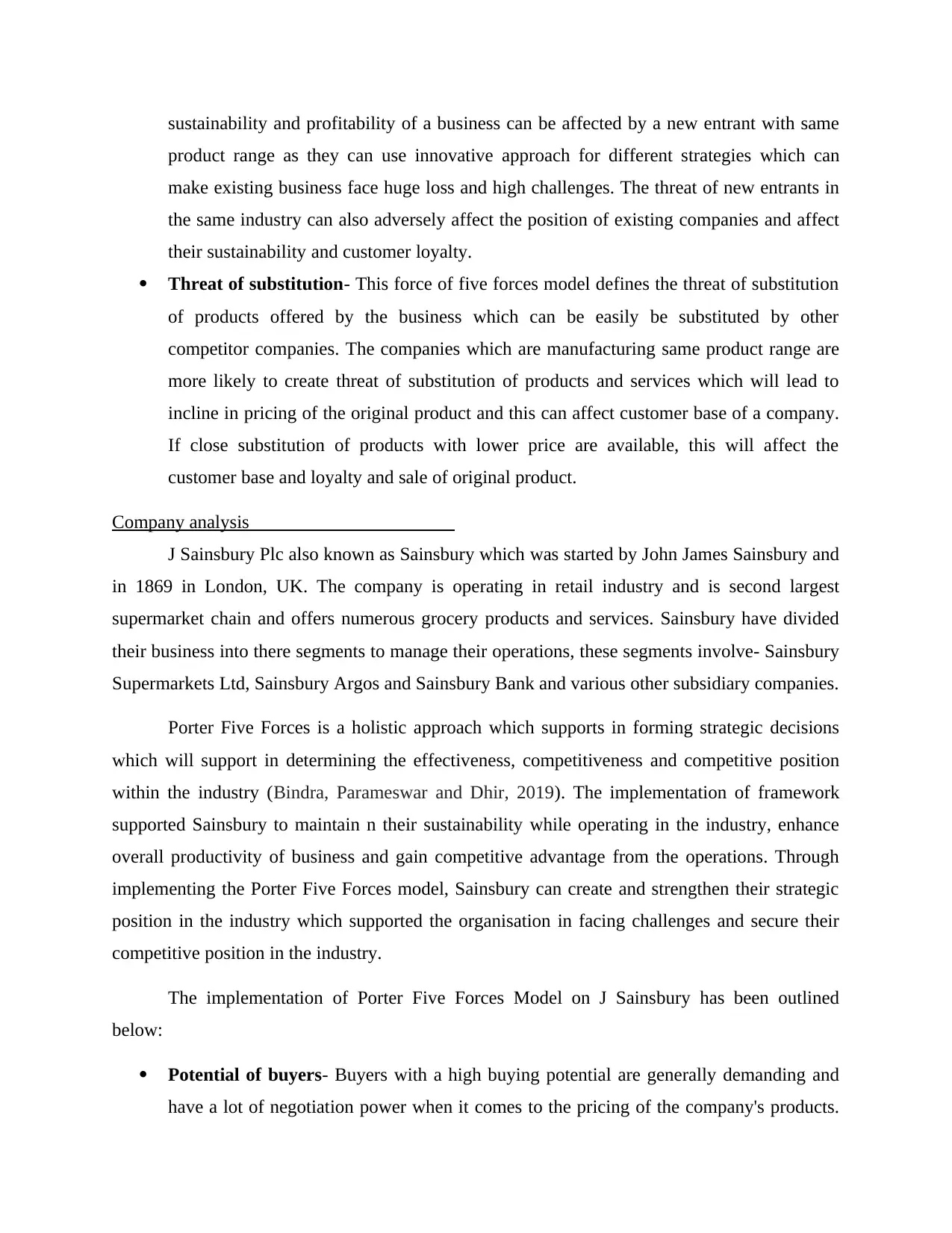
sustainability and profitability of a business can be affected by a new entrant with same
product range as they can use innovative approach for different strategies which can
make existing business face huge loss and high challenges. The threat of new entrants in
the same industry can also adversely affect the position of existing companies and affect
their sustainability and customer loyalty.
Threat of substitution- This force of five forces model defines the threat of substitution
of products offered by the business which can be easily be substituted by other
competitor companies. The companies which are manufacturing same product range are
more likely to create threat of substitution of products and services which will lead to
incline in pricing of the original product and this can affect customer base of a company.
If close substitution of products with lower price are available, this will affect the
customer base and loyalty and sale of original product.
Company analysis
J Sainsbury Plc also known as Sainsbury which was started by John James Sainsbury and
in 1869 in London, UK. The company is operating in retail industry and is second largest
supermarket chain and offers numerous grocery products and services. Sainsbury have divided
their business into there segments to manage their operations, these segments involve- Sainsbury
Supermarkets Ltd, Sainsbury Argos and Sainsbury Bank and various other subsidiary companies.
Porter Five Forces is a holistic approach which supports in forming strategic decisions
which will support in determining the effectiveness, competitiveness and competitive position
within the industry (Bindra, Parameswar and Dhir, 2019). The implementation of framework
supported Sainsbury to maintain n their sustainability while operating in the industry, enhance
overall productivity of business and gain competitive advantage from the operations. Through
implementing the Porter Five Forces model, Sainsbury can create and strengthen their strategic
position in the industry which supported the organisation in facing challenges and secure their
competitive position in the industry.
The implementation of Porter Five Forces Model on J Sainsbury has been outlined
below:
Potential of buyers- Buyers with a high buying potential are generally demanding and
have a lot of negotiation power when it comes to the pricing of the company's products.
product range as they can use innovative approach for different strategies which can
make existing business face huge loss and high challenges. The threat of new entrants in
the same industry can also adversely affect the position of existing companies and affect
their sustainability and customer loyalty.
Threat of substitution- This force of five forces model defines the threat of substitution
of products offered by the business which can be easily be substituted by other
competitor companies. The companies which are manufacturing same product range are
more likely to create threat of substitution of products and services which will lead to
incline in pricing of the original product and this can affect customer base of a company.
If close substitution of products with lower price are available, this will affect the
customer base and loyalty and sale of original product.
Company analysis
J Sainsbury Plc also known as Sainsbury which was started by John James Sainsbury and
in 1869 in London, UK. The company is operating in retail industry and is second largest
supermarket chain and offers numerous grocery products and services. Sainsbury have divided
their business into there segments to manage their operations, these segments involve- Sainsbury
Supermarkets Ltd, Sainsbury Argos and Sainsbury Bank and various other subsidiary companies.
Porter Five Forces is a holistic approach which supports in forming strategic decisions
which will support in determining the effectiveness, competitiveness and competitive position
within the industry (Bindra, Parameswar and Dhir, 2019). The implementation of framework
supported Sainsbury to maintain n their sustainability while operating in the industry, enhance
overall productivity of business and gain competitive advantage from the operations. Through
implementing the Porter Five Forces model, Sainsbury can create and strengthen their strategic
position in the industry which supported the organisation in facing challenges and secure their
competitive position in the industry.
The implementation of Porter Five Forces Model on J Sainsbury has been outlined
below:
Potential of buyers- Buyers with a high buying potential are generally demanding and
have a lot of negotiation power when it comes to the pricing of the company's products.
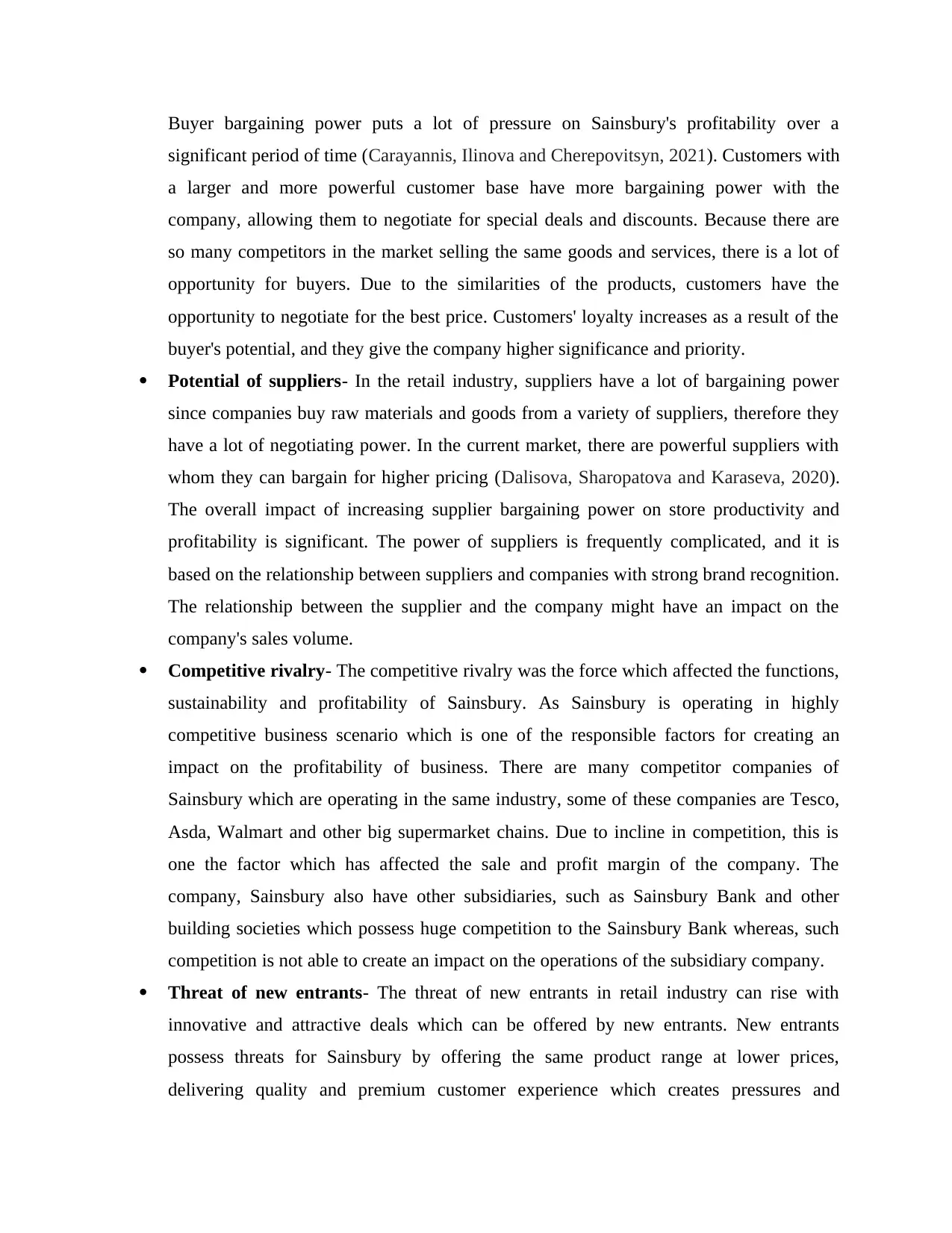
Buyer bargaining power puts a lot of pressure on Sainsbury's profitability over a
significant period of time (Carayannis, Ilinova and Cherepovitsyn, 2021). Customers with
a larger and more powerful customer base have more bargaining power with the
company, allowing them to negotiate for special deals and discounts. Because there are
so many competitors in the market selling the same goods and services, there is a lot of
opportunity for buyers. Due to the similarities of the products, customers have the
opportunity to negotiate for the best price. Customers' loyalty increases as a result of the
buyer's potential, and they give the company higher significance and priority.
Potential of suppliers- In the retail industry, suppliers have a lot of bargaining power
since companies buy raw materials and goods from a variety of suppliers, therefore they
have a lot of negotiating power. In the current market, there are powerful suppliers with
whom they can bargain for higher pricing (Dalisova, Sharopatova and Karaseva, 2020).
The overall impact of increasing supplier bargaining power on store productivity and
profitability is significant. The power of suppliers is frequently complicated, and it is
based on the relationship between suppliers and companies with strong brand recognition.
The relationship between the supplier and the company might have an impact on the
company's sales volume.
Competitive rivalry- The competitive rivalry was the force which affected the functions,
sustainability and profitability of Sainsbury. As Sainsbury is operating in highly
competitive business scenario which is one of the responsible factors for creating an
impact on the profitability of business. There are many competitor companies of
Sainsbury which are operating in the same industry, some of these companies are Tesco,
Asda, Walmart and other big supermarket chains. Due to incline in competition, this is
one the factor which has affected the sale and profit margin of the company. The
company, Sainsbury also have other subsidiaries, such as Sainsbury Bank and other
building societies which possess huge competition to the Sainsbury Bank whereas, such
competition is not able to create an impact on the operations of the subsidiary company.
Threat of new entrants- The threat of new entrants in retail industry can rise with
innovative and attractive deals which can be offered by new entrants. New entrants
possess threats for Sainsbury by offering the same product range at lower prices,
delivering quality and premium customer experience which creates pressures and
significant period of time (Carayannis, Ilinova and Cherepovitsyn, 2021). Customers with
a larger and more powerful customer base have more bargaining power with the
company, allowing them to negotiate for special deals and discounts. Because there are
so many competitors in the market selling the same goods and services, there is a lot of
opportunity for buyers. Due to the similarities of the products, customers have the
opportunity to negotiate for the best price. Customers' loyalty increases as a result of the
buyer's potential, and they give the company higher significance and priority.
Potential of suppliers- In the retail industry, suppliers have a lot of bargaining power
since companies buy raw materials and goods from a variety of suppliers, therefore they
have a lot of negotiating power. In the current market, there are powerful suppliers with
whom they can bargain for higher pricing (Dalisova, Sharopatova and Karaseva, 2020).
The overall impact of increasing supplier bargaining power on store productivity and
profitability is significant. The power of suppliers is frequently complicated, and it is
based on the relationship between suppliers and companies with strong brand recognition.
The relationship between the supplier and the company might have an impact on the
company's sales volume.
Competitive rivalry- The competitive rivalry was the force which affected the functions,
sustainability and profitability of Sainsbury. As Sainsbury is operating in highly
competitive business scenario which is one of the responsible factors for creating an
impact on the profitability of business. There are many competitor companies of
Sainsbury which are operating in the same industry, some of these companies are Tesco,
Asda, Walmart and other big supermarket chains. Due to incline in competition, this is
one the factor which has affected the sale and profit margin of the company. The
company, Sainsbury also have other subsidiaries, such as Sainsbury Bank and other
building societies which possess huge competition to the Sainsbury Bank whereas, such
competition is not able to create an impact on the operations of the subsidiary company.
Threat of new entrants- The threat of new entrants in retail industry can rise with
innovative and attractive deals which can be offered by new entrants. New entrants
possess threats for Sainsbury by offering the same product range at lower prices,
delivering quality and premium customer experience which creates pressures and
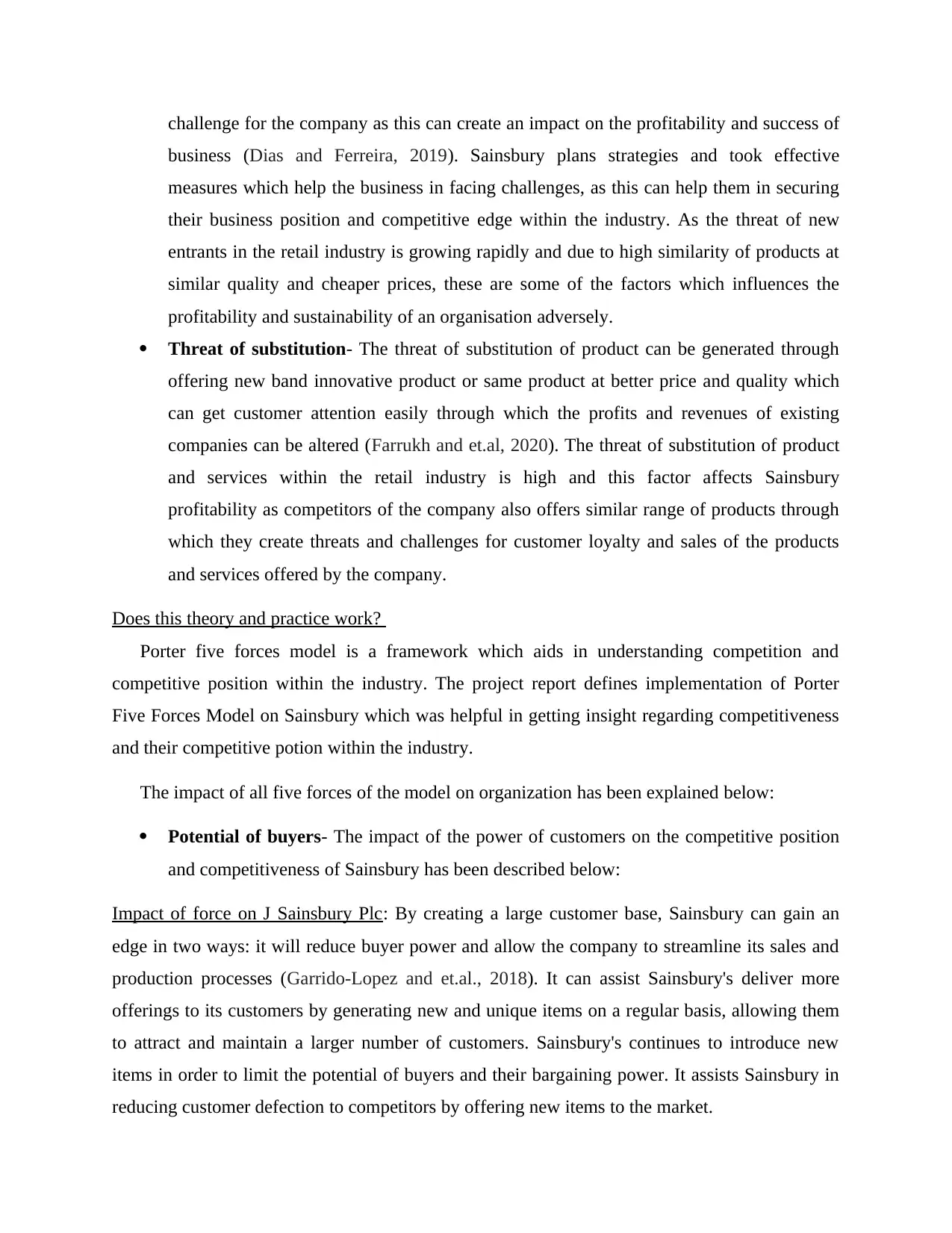
challenge for the company as this can create an impact on the profitability and success of
business (Dias and Ferreira, 2019). Sainsbury plans strategies and took effective
measures which help the business in facing challenges, as this can help them in securing
their business position and competitive edge within the industry. As the threat of new
entrants in the retail industry is growing rapidly and due to high similarity of products at
similar quality and cheaper prices, these are some of the factors which influences the
profitability and sustainability of an organisation adversely.
Threat of substitution- The threat of substitution of product can be generated through
offering new band innovative product or same product at better price and quality which
can get customer attention easily through which the profits and revenues of existing
companies can be altered (Farrukh and et.al, 2020). The threat of substitution of product
and services within the retail industry is high and this factor affects Sainsbury
profitability as competitors of the company also offers similar range of products through
which they create threats and challenges for customer loyalty and sales of the products
and services offered by the company.
Does this theory and practice work?
Porter five forces model is a framework which aids in understanding competition and
competitive position within the industry. The project report defines implementation of Porter
Five Forces Model on Sainsbury which was helpful in getting insight regarding competitiveness
and their competitive potion within the industry.
The impact of all five forces of the model on organization has been explained below:
Potential of buyers- The impact of the power of customers on the competitive position
and competitiveness of Sainsbury has been described below:
Impact of force on J Sainsbury Plc: By creating a large customer base, Sainsbury can gain an
edge in two ways: it will reduce buyer power and allow the company to streamline its sales and
production processes (Garrido-Lopez and et.al., 2018). It can assist Sainsbury's deliver more
offerings to its customers by generating new and unique items on a regular basis, allowing them
to attract and maintain a larger number of customers. Sainsbury's continues to introduce new
items in order to limit the potential of buyers and their bargaining power. It assists Sainsbury in
reducing customer defection to competitors by offering new items to the market.
business (Dias and Ferreira, 2019). Sainsbury plans strategies and took effective
measures which help the business in facing challenges, as this can help them in securing
their business position and competitive edge within the industry. As the threat of new
entrants in the retail industry is growing rapidly and due to high similarity of products at
similar quality and cheaper prices, these are some of the factors which influences the
profitability and sustainability of an organisation adversely.
Threat of substitution- The threat of substitution of product can be generated through
offering new band innovative product or same product at better price and quality which
can get customer attention easily through which the profits and revenues of existing
companies can be altered (Farrukh and et.al, 2020). The threat of substitution of product
and services within the retail industry is high and this factor affects Sainsbury
profitability as competitors of the company also offers similar range of products through
which they create threats and challenges for customer loyalty and sales of the products
and services offered by the company.
Does this theory and practice work?
Porter five forces model is a framework which aids in understanding competition and
competitive position within the industry. The project report defines implementation of Porter
Five Forces Model on Sainsbury which was helpful in getting insight regarding competitiveness
and their competitive potion within the industry.
The impact of all five forces of the model on organization has been explained below:
Potential of buyers- The impact of the power of customers on the competitive position
and competitiveness of Sainsbury has been described below:
Impact of force on J Sainsbury Plc: By creating a large customer base, Sainsbury can gain an
edge in two ways: it will reduce buyer power and allow the company to streamline its sales and
production processes (Garrido-Lopez and et.al., 2018). It can assist Sainsbury's deliver more
offerings to its customers by generating new and unique items on a regular basis, allowing them
to attract and maintain a larger number of customers. Sainsbury's continues to introduce new
items in order to limit the potential of buyers and their bargaining power. It assists Sainsbury in
reducing customer defection to competitors by offering new items to the market.
Paraphrase This Document
Need a fresh take? Get an instant paraphrase of this document with our AI Paraphraser
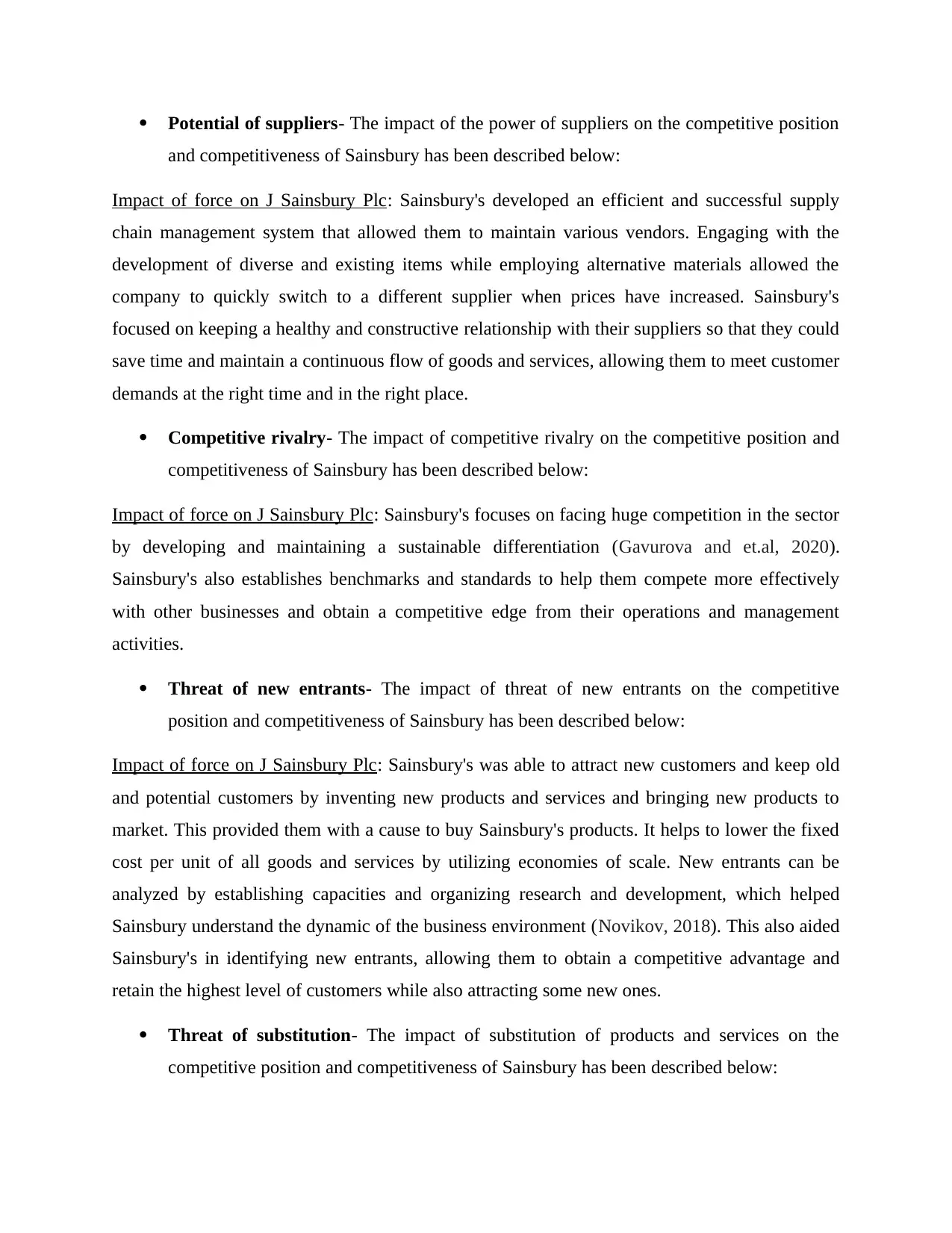
Potential of suppliers- The impact of the power of suppliers on the competitive position
and competitiveness of Sainsbury has been described below:
Impact of force on J Sainsbury Plc: Sainsbury's developed an efficient and successful supply
chain management system that allowed them to maintain various vendors. Engaging with the
development of diverse and existing items while employing alternative materials allowed the
company to quickly switch to a different supplier when prices have increased. Sainsbury's
focused on keeping a healthy and constructive relationship with their suppliers so that they could
save time and maintain a continuous flow of goods and services, allowing them to meet customer
demands at the right time and in the right place.
Competitive rivalry- The impact of competitive rivalry on the competitive position and
competitiveness of Sainsbury has been described below:
Impact of force on J Sainsbury Plc: Sainsbury's focuses on facing huge competition in the sector
by developing and maintaining a sustainable differentiation (Gavurova and et.al, 2020).
Sainsbury's also establishes benchmarks and standards to help them compete more effectively
with other businesses and obtain a competitive edge from their operations and management
activities.
Threat of new entrants- The impact of threat of new entrants on the competitive
position and competitiveness of Sainsbury has been described below:
Impact of force on J Sainsbury Plc: Sainsbury's was able to attract new customers and keep old
and potential customers by inventing new products and services and bringing new products to
market. This provided them with a cause to buy Sainsbury's products. It helps to lower the fixed
cost per unit of all goods and services by utilizing economies of scale. New entrants can be
analyzed by establishing capacities and organizing research and development, which helped
Sainsbury understand the dynamic of the business environment (Novikov, 2018). This also aided
Sainsbury's in identifying new entrants, allowing them to obtain a competitive advantage and
retain the highest level of customers while also attracting some new ones.
Threat of substitution- The impact of substitution of products and services on the
competitive position and competitiveness of Sainsbury has been described below:
and competitiveness of Sainsbury has been described below:
Impact of force on J Sainsbury Plc: Sainsbury's developed an efficient and successful supply
chain management system that allowed them to maintain various vendors. Engaging with the
development of diverse and existing items while employing alternative materials allowed the
company to quickly switch to a different supplier when prices have increased. Sainsbury's
focused on keeping a healthy and constructive relationship with their suppliers so that they could
save time and maintain a continuous flow of goods and services, allowing them to meet customer
demands at the right time and in the right place.
Competitive rivalry- The impact of competitive rivalry on the competitive position and
competitiveness of Sainsbury has been described below:
Impact of force on J Sainsbury Plc: Sainsbury's focuses on facing huge competition in the sector
by developing and maintaining a sustainable differentiation (Gavurova and et.al, 2020).
Sainsbury's also establishes benchmarks and standards to help them compete more effectively
with other businesses and obtain a competitive edge from their operations and management
activities.
Threat of new entrants- The impact of threat of new entrants on the competitive
position and competitiveness of Sainsbury has been described below:
Impact of force on J Sainsbury Plc: Sainsbury's was able to attract new customers and keep old
and potential customers by inventing new products and services and bringing new products to
market. This provided them with a cause to buy Sainsbury's products. It helps to lower the fixed
cost per unit of all goods and services by utilizing economies of scale. New entrants can be
analyzed by establishing capacities and organizing research and development, which helped
Sainsbury understand the dynamic of the business environment (Novikov, 2018). This also aided
Sainsbury's in identifying new entrants, allowing them to obtain a competitive advantage and
retain the highest level of customers while also attracting some new ones.
Threat of substitution- The impact of substitution of products and services on the
competitive position and competitiveness of Sainsbury has been described below:
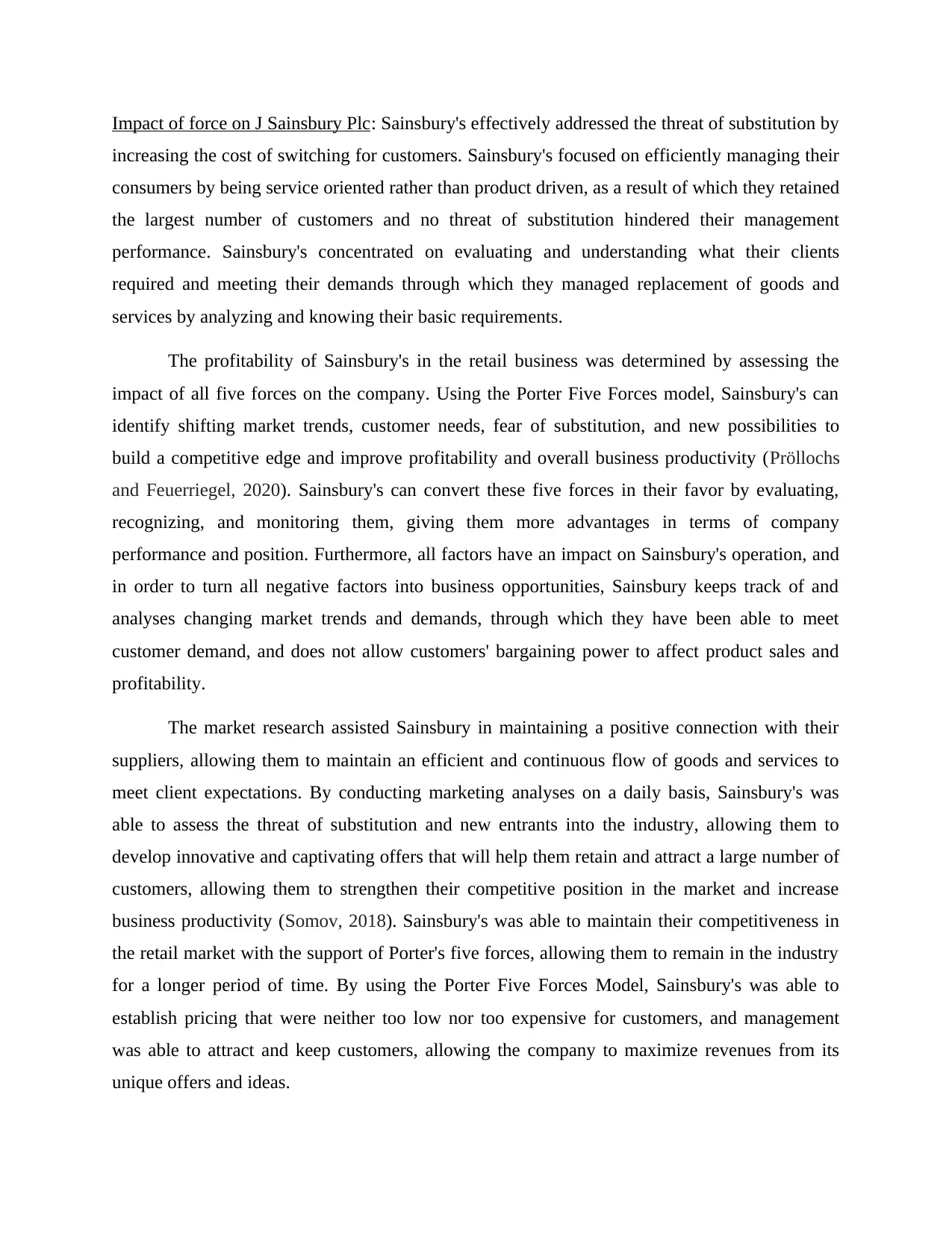
Impact of force on J Sainsbury Plc: Sainsbury's effectively addressed the threat of substitution by
increasing the cost of switching for customers. Sainsbury's focused on efficiently managing their
consumers by being service oriented rather than product driven, as a result of which they retained
the largest number of customers and no threat of substitution hindered their management
performance. Sainsbury's concentrated on evaluating and understanding what their clients
required and meeting their demands through which they managed replacement of goods and
services by analyzing and knowing their basic requirements.
The profitability of Sainsbury's in the retail business was determined by assessing the
impact of all five forces on the company. Using the Porter Five Forces model, Sainsbury's can
identify shifting market trends, customer needs, fear of substitution, and new possibilities to
build a competitive edge and improve profitability and overall business productivity (Pröllochs
and Feuerriegel, 2020). Sainsbury's can convert these five forces in their favor by evaluating,
recognizing, and monitoring them, giving them more advantages in terms of company
performance and position. Furthermore, all factors have an impact on Sainsbury's operation, and
in order to turn all negative factors into business opportunities, Sainsbury keeps track of and
analyses changing market trends and demands, through which they have been able to meet
customer demand, and does not allow customers' bargaining power to affect product sales and
profitability.
The market research assisted Sainsbury in maintaining a positive connection with their
suppliers, allowing them to maintain an efficient and continuous flow of goods and services to
meet client expectations. By conducting marketing analyses on a daily basis, Sainsbury's was
able to assess the threat of substitution and new entrants into the industry, allowing them to
develop innovative and captivating offers that will help them retain and attract a large number of
customers, allowing them to strengthen their competitive position in the market and increase
business productivity (Somov, 2018). Sainsbury's was able to maintain their competitiveness in
the retail market with the support of Porter's five forces, allowing them to remain in the industry
for a longer period of time. By using the Porter Five Forces Model, Sainsbury's was able to
establish pricing that were neither too low nor too expensive for customers, and management
was able to attract and keep customers, allowing the company to maximize revenues from its
unique offers and ideas.
increasing the cost of switching for customers. Sainsbury's focused on efficiently managing their
consumers by being service oriented rather than product driven, as a result of which they retained
the largest number of customers and no threat of substitution hindered their management
performance. Sainsbury's concentrated on evaluating and understanding what their clients
required and meeting their demands through which they managed replacement of goods and
services by analyzing and knowing their basic requirements.
The profitability of Sainsbury's in the retail business was determined by assessing the
impact of all five forces on the company. Using the Porter Five Forces model, Sainsbury's can
identify shifting market trends, customer needs, fear of substitution, and new possibilities to
build a competitive edge and improve profitability and overall business productivity (Pröllochs
and Feuerriegel, 2020). Sainsbury's can convert these five forces in their favor by evaluating,
recognizing, and monitoring them, giving them more advantages in terms of company
performance and position. Furthermore, all factors have an impact on Sainsbury's operation, and
in order to turn all negative factors into business opportunities, Sainsbury keeps track of and
analyses changing market trends and demands, through which they have been able to meet
customer demand, and does not allow customers' bargaining power to affect product sales and
profitability.
The market research assisted Sainsbury in maintaining a positive connection with their
suppliers, allowing them to maintain an efficient and continuous flow of goods and services to
meet client expectations. By conducting marketing analyses on a daily basis, Sainsbury's was
able to assess the threat of substitution and new entrants into the industry, allowing them to
develop innovative and captivating offers that will help them retain and attract a large number of
customers, allowing them to strengthen their competitive position in the market and increase
business productivity (Somov, 2018). Sainsbury's was able to maintain their competitiveness in
the retail market with the support of Porter's five forces, allowing them to remain in the industry
for a longer period of time. By using the Porter Five Forces Model, Sainsbury's was able to
establish pricing that were neither too low nor too expensive for customers, and management
was able to attract and keep customers, allowing the company to maximize revenues from its
unique offers and ideas.
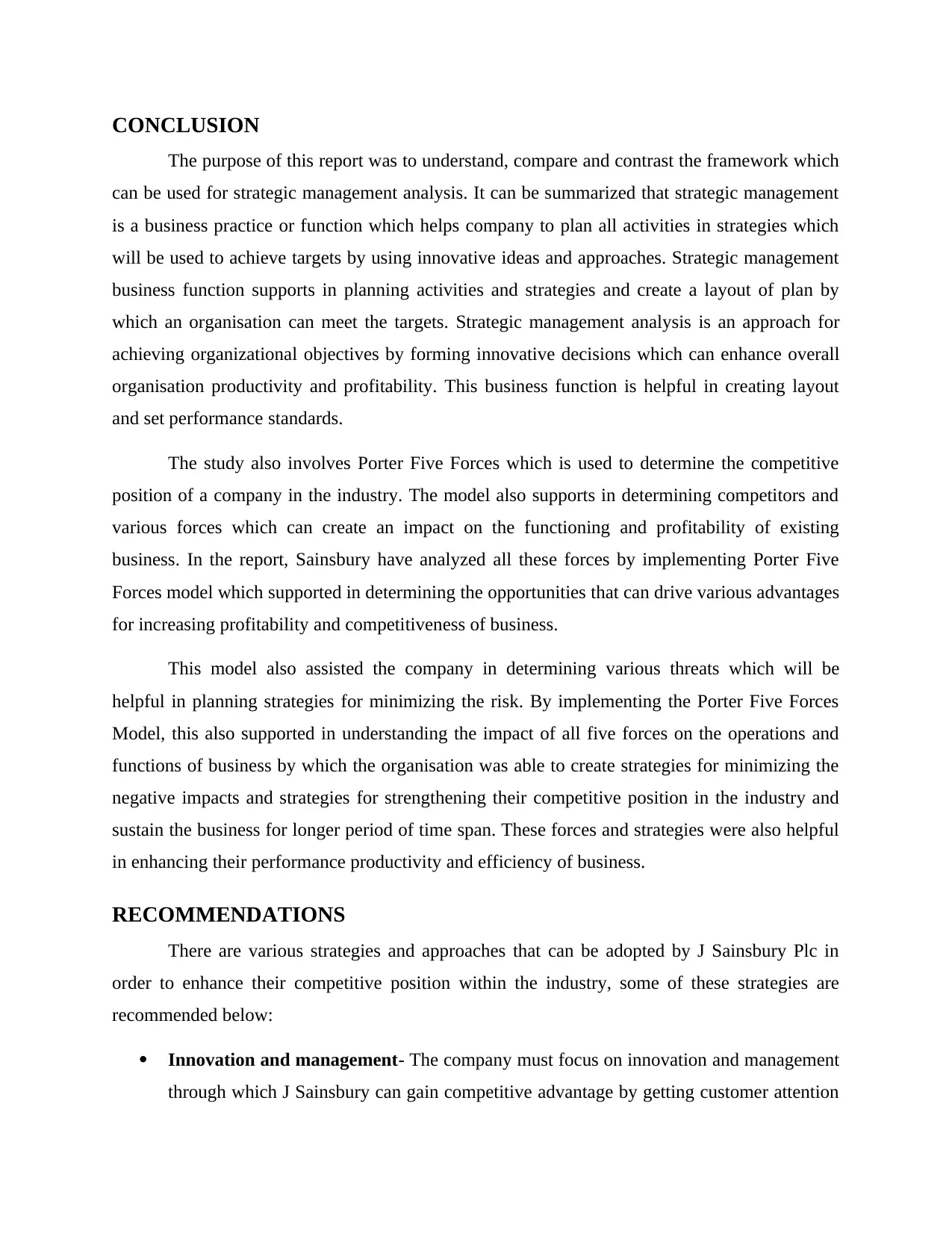
CONCLUSION
The purpose of this report was to understand, compare and contrast the framework which
can be used for strategic management analysis. It can be summarized that strategic management
is a business practice or function which helps company to plan all activities in strategies which
will be used to achieve targets by using innovative ideas and approaches. Strategic management
business function supports in planning activities and strategies and create a layout of plan by
which an organisation can meet the targets. Strategic management analysis is an approach for
achieving organizational objectives by forming innovative decisions which can enhance overall
organisation productivity and profitability. This business function is helpful in creating layout
and set performance standards.
The study also involves Porter Five Forces which is used to determine the competitive
position of a company in the industry. The model also supports in determining competitors and
various forces which can create an impact on the functioning and profitability of existing
business. In the report, Sainsbury have analyzed all these forces by implementing Porter Five
Forces model which supported in determining the opportunities that can drive various advantages
for increasing profitability and competitiveness of business.
This model also assisted the company in determining various threats which will be
helpful in planning strategies for minimizing the risk. By implementing the Porter Five Forces
Model, this also supported in understanding the impact of all five forces on the operations and
functions of business by which the organisation was able to create strategies for minimizing the
negative impacts and strategies for strengthening their competitive position in the industry and
sustain the business for longer period of time span. These forces and strategies were also helpful
in enhancing their performance productivity and efficiency of business.
RECOMMENDATIONS
There are various strategies and approaches that can be adopted by J Sainsbury Plc in
order to enhance their competitive position within the industry, some of these strategies are
recommended below:
Innovation and management- The company must focus on innovation and management
through which J Sainsbury can gain competitive advantage by getting customer attention
The purpose of this report was to understand, compare and contrast the framework which
can be used for strategic management analysis. It can be summarized that strategic management
is a business practice or function which helps company to plan all activities in strategies which
will be used to achieve targets by using innovative ideas and approaches. Strategic management
business function supports in planning activities and strategies and create a layout of plan by
which an organisation can meet the targets. Strategic management analysis is an approach for
achieving organizational objectives by forming innovative decisions which can enhance overall
organisation productivity and profitability. This business function is helpful in creating layout
and set performance standards.
The study also involves Porter Five Forces which is used to determine the competitive
position of a company in the industry. The model also supports in determining competitors and
various forces which can create an impact on the functioning and profitability of existing
business. In the report, Sainsbury have analyzed all these forces by implementing Porter Five
Forces model which supported in determining the opportunities that can drive various advantages
for increasing profitability and competitiveness of business.
This model also assisted the company in determining various threats which will be
helpful in planning strategies for minimizing the risk. By implementing the Porter Five Forces
Model, this also supported in understanding the impact of all five forces on the operations and
functions of business by which the organisation was able to create strategies for minimizing the
negative impacts and strategies for strengthening their competitive position in the industry and
sustain the business for longer period of time span. These forces and strategies were also helpful
in enhancing their performance productivity and efficiency of business.
RECOMMENDATIONS
There are various strategies and approaches that can be adopted by J Sainsbury Plc in
order to enhance their competitive position within the industry, some of these strategies are
recommended below:
Innovation and management- The company must focus on innovation and management
through which J Sainsbury can gain competitive advantage by getting customer attention
Secure Best Marks with AI Grader
Need help grading? Try our AI Grader for instant feedback on your assignments.
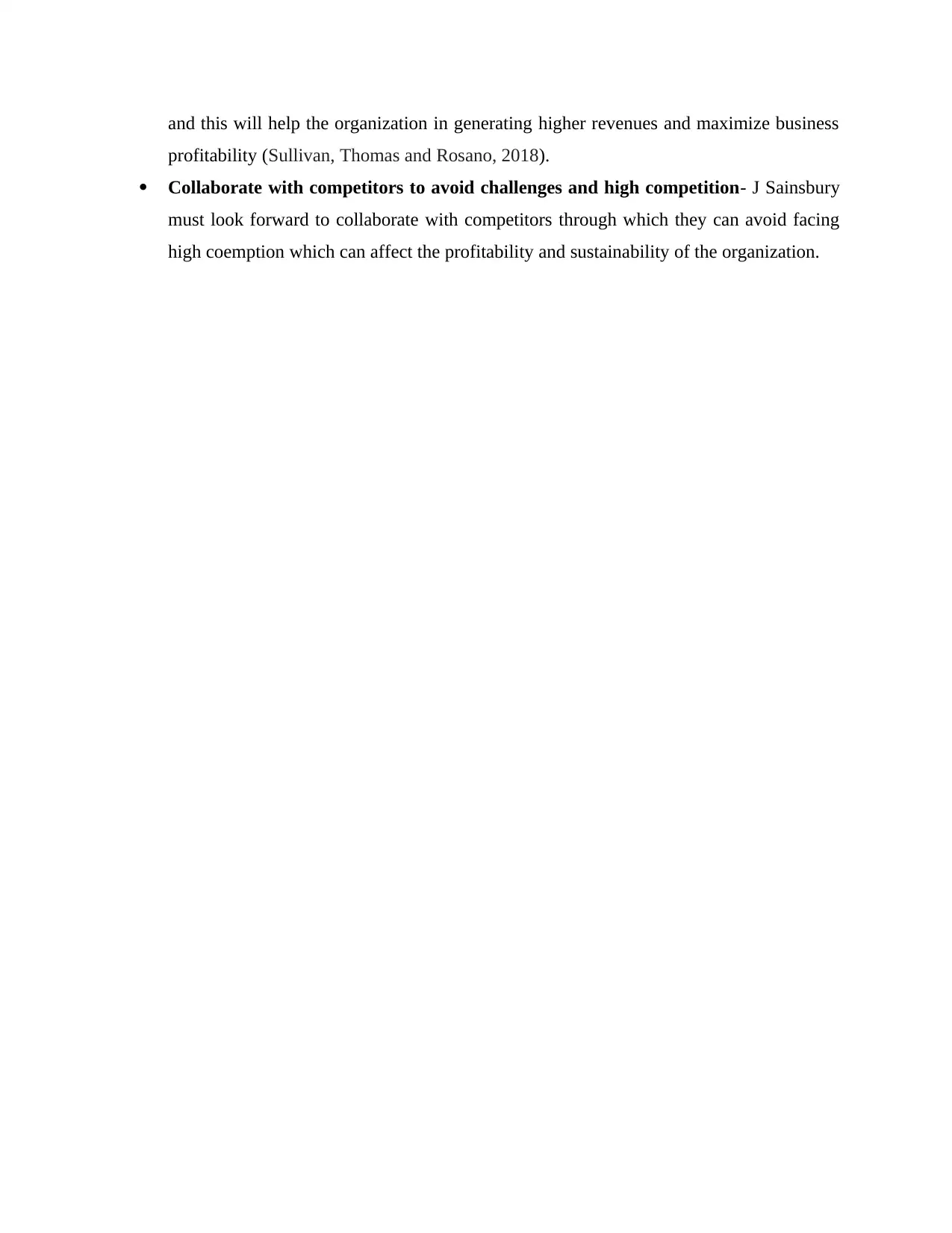
and this will help the organization in generating higher revenues and maximize business
profitability (Sullivan, Thomas and Rosano, 2018).
Collaborate with competitors to avoid challenges and high competition- J Sainsbury
must look forward to collaborate with competitors through which they can avoid facing
high coemption which can affect the profitability and sustainability of the organization.
profitability (Sullivan, Thomas and Rosano, 2018).
Collaborate with competitors to avoid challenges and high competition- J Sainsbury
must look forward to collaborate with competitors through which they can avoid facing
high coemption which can affect the profitability and sustainability of the organization.
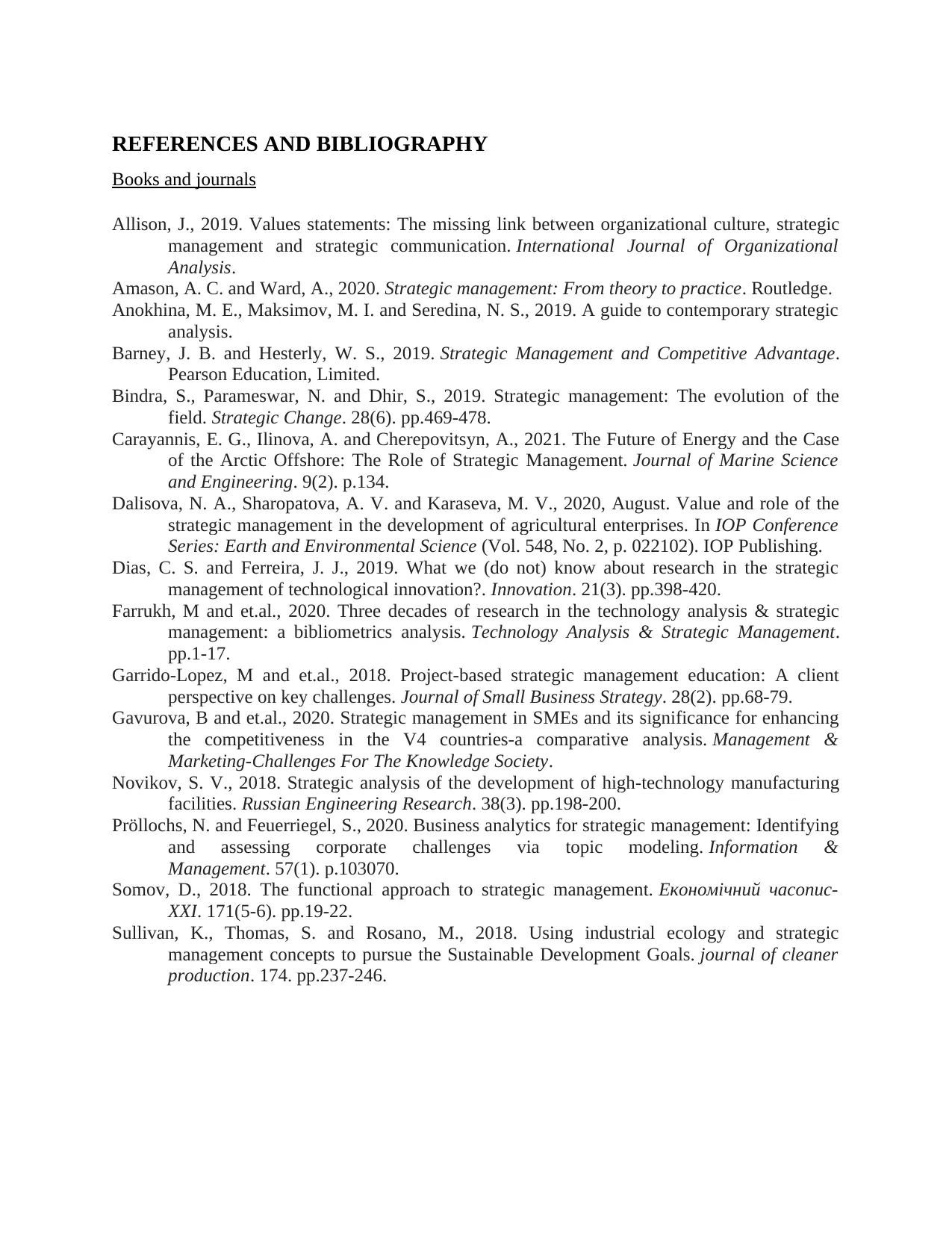
REFERENCES AND BIBLIOGRAPHY
Books and journals
Allison, J., 2019. Values statements: The missing link between organizational culture, strategic
management and strategic communication. International Journal of Organizational
Analysis.
Amason, A. C. and Ward, A., 2020. Strategic management: From theory to practice. Routledge.
Anokhina, M. E., Maksimov, M. I. and Seredina, N. S., 2019. A guide to contemporary strategic
analysis.
Barney, J. B. and Hesterly, W. S., 2019. Strategic Management and Competitive Advantage.
Pearson Education, Limited.
Bindra, S., Parameswar, N. and Dhir, S., 2019. Strategic management: The evolution of the
field. Strategic Change. 28(6). pp.469-478.
Carayannis, E. G., Ilinova, A. and Cherepovitsyn, A., 2021. The Future of Energy and the Case
of the Arctic Offshore: The Role of Strategic Management. Journal of Marine Science
and Engineering. 9(2). p.134.
Dalisova, N. A., Sharopatova, A. V. and Karaseva, M. V., 2020, August. Value and role of the
strategic management in the development of agricultural enterprises. In IOP Conference
Series: Earth and Environmental Science (Vol. 548, No. 2, p. 022102). IOP Publishing.
Dias, C. S. and Ferreira, J. J., 2019. What we (do not) know about research in the strategic
management of technological innovation?. Innovation. 21(3). pp.398-420.
Farrukh, M and et.al., 2020. Three decades of research in the technology analysis & strategic
management: a bibliometrics analysis. Technology Analysis & Strategic Management.
pp.1-17.
Garrido-Lopez, M and et.al., 2018. Project-based strategic management education: A client
perspective on key challenges. Journal of Small Business Strategy. 28(2). pp.68-79.
Gavurova, B and et.al., 2020. Strategic management in SMEs and its significance for enhancing
the competitiveness in the V4 countries-a comparative analysis. Management &
Marketing-Challenges For The Knowledge Society.
Novikov, S. V., 2018. Strategic analysis of the development of high-technology manufacturing
facilities. Russian Engineering Research. 38(3). pp.198-200.
Pröllochs, N. and Feuerriegel, S., 2020. Business analytics for strategic management: Identifying
and assessing corporate challenges via topic modeling. Information &
Management. 57(1). p.103070.
Somov, D., 2018. The functional approach to strategic management. Економічний часопис-
ХХІ. 171(5-6). pp.19-22.
Sullivan, K., Thomas, S. and Rosano, M., 2018. Using industrial ecology and strategic
management concepts to pursue the Sustainable Development Goals. journal of cleaner
production. 174. pp.237-246.
Books and journals
Allison, J., 2019. Values statements: The missing link between organizational culture, strategic
management and strategic communication. International Journal of Organizational
Analysis.
Amason, A. C. and Ward, A., 2020. Strategic management: From theory to practice. Routledge.
Anokhina, M. E., Maksimov, M. I. and Seredina, N. S., 2019. A guide to contemporary strategic
analysis.
Barney, J. B. and Hesterly, W. S., 2019. Strategic Management and Competitive Advantage.
Pearson Education, Limited.
Bindra, S., Parameswar, N. and Dhir, S., 2019. Strategic management: The evolution of the
field. Strategic Change. 28(6). pp.469-478.
Carayannis, E. G., Ilinova, A. and Cherepovitsyn, A., 2021. The Future of Energy and the Case
of the Arctic Offshore: The Role of Strategic Management. Journal of Marine Science
and Engineering. 9(2). p.134.
Dalisova, N. A., Sharopatova, A. V. and Karaseva, M. V., 2020, August. Value and role of the
strategic management in the development of agricultural enterprises. In IOP Conference
Series: Earth and Environmental Science (Vol. 548, No. 2, p. 022102). IOP Publishing.
Dias, C. S. and Ferreira, J. J., 2019. What we (do not) know about research in the strategic
management of technological innovation?. Innovation. 21(3). pp.398-420.
Farrukh, M and et.al., 2020. Three decades of research in the technology analysis & strategic
management: a bibliometrics analysis. Technology Analysis & Strategic Management.
pp.1-17.
Garrido-Lopez, M and et.al., 2018. Project-based strategic management education: A client
perspective on key challenges. Journal of Small Business Strategy. 28(2). pp.68-79.
Gavurova, B and et.al., 2020. Strategic management in SMEs and its significance for enhancing
the competitiveness in the V4 countries-a comparative analysis. Management &
Marketing-Challenges For The Knowledge Society.
Novikov, S. V., 2018. Strategic analysis of the development of high-technology manufacturing
facilities. Russian Engineering Research. 38(3). pp.198-200.
Pröllochs, N. and Feuerriegel, S., 2020. Business analytics for strategic management: Identifying
and assessing corporate challenges via topic modeling. Information &
Management. 57(1). p.103070.
Somov, D., 2018. The functional approach to strategic management. Економічний часопис-
ХХІ. 171(5-6). pp.19-22.
Sullivan, K., Thomas, S. and Rosano, M., 2018. Using industrial ecology and strategic
management concepts to pursue the Sustainable Development Goals. journal of cleaner
production. 174. pp.237-246.
1 out of 12
Related Documents
Your All-in-One AI-Powered Toolkit for Academic Success.
+13062052269
info@desklib.com
Available 24*7 on WhatsApp / Email
![[object Object]](/_next/static/media/star-bottom.7253800d.svg)
Unlock your academic potential
© 2024 | Zucol Services PVT LTD | All rights reserved.




